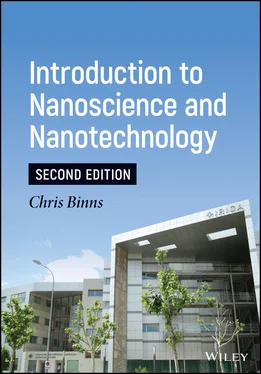1 Cover
2 Title Page
3 Copyright Page
4 Preface to Second Edition
5 Acknowledgments
6 Introduction to Second Edition I.1 Incremental Nanotechnology I.2 Evolutionary Nanotechnology I.3 Radical Nanotechnology I.4 Bottom–Up/Top–Down Nanotechnology References
7 1 Size Matters1.1 The Fundamental Importance of Size 1.2 The Magnetic Behavior of Nanoparticles 1.3 The Mechanical Properties of Nanostructured Materials 1.4 The Chemical Properties of Nanoparticles 1.5 Nanoparticles Interacting with Bacteria and Viruses Problems References
8 2 Nanoparticles and the Environment 2.1 Nanoparticles in the Atmosphere 2.2 Atmospheric Nanoparticles and Health 2.3 Nanoparticles and Clouds 2.4 Marine Aerosol 2.5 Effect of Cosmic Rays on Atmospheric Aerosol 2.6 Nanoparticles in Space 2.7 Environmental Applications of Nanoparticles Problems References
9 3 Carbon Nanostructures 3.1 Why Carbon? 3.2 Discovery of the First Fullerene – C 60 3.3 Structural Symmetry of the Closed Fullerenes 3.4 Smaller Fullerenes and “Shrink‐Wrapping” Atoms 3.5 Larger Fullerenes 3.6 Electronic Properties of Individual Fullerenes 3.7 Materials Produced by Assembling Fullerenes (Fullerites and Fullerides) 3.8 Discovery of Carbon Nanotubes 3.9 Structure of Single‐Wall Carbon Nanotubes (SWNTs) 3.10 Electronic Properties of SWNTs 3.11 Electronic Transport in Carbon Nanotubes 3.12 Field Emission from Carbon Nanotubes 3.13 Mechanical Properties of Nanotubes 3.14 Thermal Conductivity of Nanotubes 3.15 Carbon Nanohorns 3.16 Carbon Nanobuds and Pea Pods Problems References
10 4 Graphene 4.1 Background 4.2 Electrical Properties of Graphene 4.3 Graphene as a Testbed for Relativistic Quantum Effects 4.4 Thermal Conductivity of Graphene 4.5 Mechanical Strength of Graphene 4.6 Superconductivity in Graphene Bilayers 4.7 Current Technological Applications of Graphene 4.8 Summary Problems References
11 5 The Nanotechnology Toolkit 5.1 Making Nanostructures Using Bottom–Up Methods 5.2 Making Nanostructures Using Top–Down Methods 5.3 Combining Bottom–up and Top–Down Nanostructures 5.4 Imaging, Probing, and Manipulating Nanostructures References
12 6 Single‐Nanoparticles Devices 6.1 Data Storage on Magnetic Nanoparticles 6.2 Quantum Dots 6.3 Quantum Dot Solar Cells 6.4 Nanoparticles as Transistors 6.5 Carbon Nano‐Electronics 6.6 Carbon Nanotube Light Emitters and Detectors References
13 7 Hydrosols, Nanobubbles, and Nanoscale Interfaces 7.1 Reynolds Number 7.2 Brownian Motion 7.3 Stability of Hydrosols 7.4 Nanobubbles 7.5 Nanofluidics References
14 8 Magic Beacons and Magic Bullets 8.1 Nanoparticles Interacting with Living Organisms 8.2 Treatment of Tumors by Hyperthermia 8.3 Medical Diagnosis and “Theranostics” using Nanomaterials 8.4 Antibacterial and Antiviral Applications of Nanoparticles References
15 9 Radical Nanotechnology 9.1 Locomotion for Nanobots and Nanofactories 9.2 Onboard Processing for Nanomachines 9.3 Medical Micro/Nanobots 9.4 Molecular Assembly References
16 10 Prodding the Cosmic Fabric 10.1 Zero‐Point Energy of Space 10.2 The Casimir Force 10.3 The Casimir Force in Micro‐ and Nanomachines 10.4 Controlling the Casimir Force Using Phase‐Change Materials 10.5 Repulsive Casimir Forces References
17 Glossary
18 Index
19 End User License Agreement
1 Chapter 3 Table 3.1 HOMO‐LUMO gaps for fullerenes on various surfaces. Table 3.2 Comparison of the Properties of Fullerite and Silicon.Table 3.3 Superconducting transition temperatures of the Fullerides.
2 Chapter 6Table 6.1 Characteristics of various SET devices.
3 Chapter 7Table 7.1 Hamaker constant at 300 K for nanoparticles with a radius of 10 n...
4 Chapter 8Table 8.1 Examples of membrane proteins.Table 8.2 Organelles within the Protoplasm.Table 8.3 Physical and thermal properties of various tissues and blood.Table 8.4 Comparison of SARs of various magnetic nanoparticles.Table 8.5 R 2relaxivities for different magnetic nanoparticle contrast agents.
1 c00 Figure I.1 The nanoworld.The size range of interest in nanotechnology and s... Figure I.2 Ancient incremental nanotechnology.Copper nanocrystals of about ... Figure I.3 Evolutionary nanotechnology – a single nanoparticle acting as a d... Figure I.4 Self‐assembly of single‐nanoparticle transistors.Ill... Figure I.5 Theranostic nanoparticle for the diagnosis and treatment of cance... Figure I.6 The smallest wineglass in the World (authorised by Guinness World... Figure I.7 Top–down nanotechnology used to attach electrodes to a nanopartic...
2 Chapter 1 Figure 1.1 Manganese nanoparticles on bucky balls.STM image (see Chapter 5,... Figure 1.2 Distance range encompassing all current scientific knowledge.Dis... Figure 1.3 Democritus.Bronze bust thought to be of Democritus at the Naples... Figure 1.4 Simple experiment to demonstrate magnetic domains.(a) Soft Fe do... Figure 1.5 Single‐domain particles.Domain formation in Fe to minimize... Figure 1.6 Magnetic bacterium using single‐domain particles. The Magne... Figure 1.7 Size‐dependent behavior in nanoparticles.For particles sma... Figure 1.8 Measuring the magnetic moment in free nanoparticles.The magnetic... Figure 1.9 Measured magnetic moments per atom in magnetic nanoparticles.Exp... Figure 1.10 Morphology of nanoparticle film.STM image (see Chapter 5, Secti... Figure 1.11 Producing nanostructured films by cluster beam deposition.Nanos... Figure 1.12 High‐moment films produced by cluster beam deposition.Mag... Figure 1.13 Grain size in nanostructured materials.Electron microscope imag... Figure 1.14 Yield strength of aluminum alloys.Comparison of Deformation (St... Figure 1.15 Reactivity of gold nanoparticles.Measured activities of gold na... Figure 1.16 Silver nanoparticles attacking bacteria. Electron microscope ima... Figure 1.17 Silver nanoparticles attached to HIV‐1.(a) Computer‐gener...
3 Chapter 2 Figure 2.1 Sources of background nanoparticles.(a) Volcanoes and (b) forest... Figure 2.2 Size distribution of urban aerosol.The concentration of airborne... Figure 2.3 Nanoparticles produced by candles.The size distribution of parti... Figure 2.4 Nanoparticles and the lungs.(a) Anatomy of finest bronchial tube... Figure 2.5 Translocation of Au nanoparticles from the lungs into blood circu... Figure 2.6 Frustrated phagocytosis.Scanning electron microscopy image of ma... Figure 2.7 Villi and microvilli of the small intestine.The surface of the c... Figure 2.8 Structure of skin. Human skin consists of three basic layers labe... Figure 2.9 Relative sizes of particles involved in clouds.Comparison of a C... Figure 2.10 Effect of nanoparticles on DCCs.In clouds that lack nanoparticl... Figure 2.11 Phytoplankton bloom in the North Sea.Clouds of phytoplankton ar... Figure 2.12 Composition of particles produced by phytoplankton.(a) Seasonal... Figure 2.13 Maunder minimum and the little ice age.The Plot, using historic... Figure 2.14 Rosetta mission to comet 67P/Churyumov‐Gerasimenko.(a) Ph... Figure 2.15 Pollution of soil and groundwater by anthropogenic activities.R... Figure 2.16 Application of nZVI particles to groundwater remediation.In the... Figure 2.17 Magnetic separation of Pb contamination from water.(a) Suspensi... Figure 2.18 Polymerization of ethylene to produce polyethylene.(a) Ethylene... Figure 2.19 Catalyst for upscaling waste plastic.(a) Pt particles with a di...
Читать дальше












